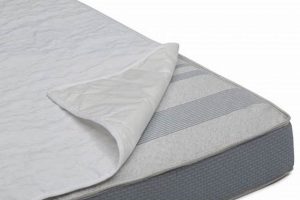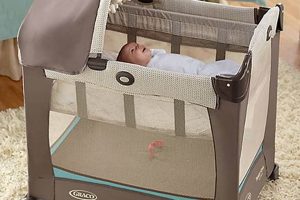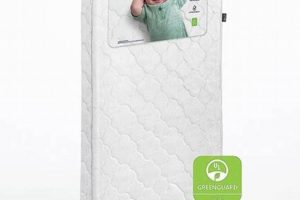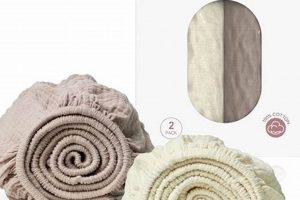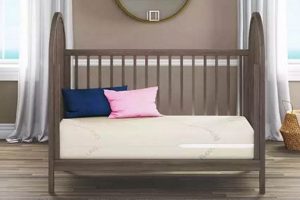A sleeping surface designed for infants, typically constructed from flexible polyurethane material, offers a lightweight and potentially comfortable foundation for a crib. Density and firmness are key characteristics, influencing support and safety. These products are available in varying thicknesses and sizes to conform to standard crib dimensions.
The selection of a proper infant sleep surface is paramount for safety and developmental well-being. Adequate firmness contributes to reducing the risk of suffocation and promoting healthy skeletal alignment during early growth stages. Advances in material science have led to enhanced durability and breathability, providing improvements over older, less sophisticated designs.
Subsequent sections will address specific safety standards, material composition analyses, cleaning and maintenance procedures, and potential considerations for choosing a model suitable for specific needs. Further research will explore the comparison between different material types, including innerspring options, as well as providing guidelines for disposal and environmental impact.
Foam Crib Mattress
Selecting the correct infant sleep surface requires careful evaluation. The following considerations aim to guide informed purchasing decisions, promoting safety and optimal infant well-being.
Tip 1: Firmness Assessment: Evaluate firmness levels to ensure adequate support. A surface that yields excessively may present a suffocation hazard. Press firmly into the center and edges to assess consistency.
Tip 2: Size Conformance: Verify that the dimensions precisely match the interior dimensions of the crib frame. Gaps between the edge and the frame pose a potential entrapment risk.
Tip 3: Material Certification: Prioritize models certified by reputable organizations, indicating adherence to safety standards regarding chemicals and emissions. Look for certifications such as CertiPUR-US.
Tip 4: Breathability Considerations: Opt for options with enhanced breathability features, such as perforated designs or breathable covers, to minimize the risk of overheating and promote air circulation.
Tip 5: Cleaning and Maintenance: Inquire about cleaning recommendations and select models with waterproof or water-resistant covers to facilitate easy maintenance and prevent moisture accumulation.
Tip 6: Weight Considerations: Evaluate the weight for ease of lifting and changing linens. A lighter model simplifies these tasks without compromising support.
Tip 7: Review Warranty: Examine the warranty terms to understand the manufacturer’s commitment to product durability and performance. A comprehensive warranty provides assurance of quality.
Adherence to these guidelines significantly enhances the safety and suitability of the selected infant sleep surface. Rigorous evaluation ensures a secure and supportive environment for optimal infant development.
The subsequent sections will delve into comparative analyses of material types and offer additional insights into maintaining hygiene and prolonging the product’s lifespan.
1. Firmness Standards
The firmness of an infant sleep surface is a critical safety parameter directly influencing the risk of Sudden Infant Death Syndrome (SIDS) and suffocation. Regulatory bodies and pediatric health organizations establish standards to ensure adequate support for infants.
- Minimum Firmness Requirement
Standards mandate a minimum level of firmness to prevent the infant from sinking into the surface, which could obstruct breathing. This requirement is typically assessed through standardized compression tests. Failure to meet minimum firmness levels renders a product non-compliant and potentially hazardous.
- Compression Testing Methodologies
Testing involves applying a controlled force to the surface and measuring the resulting indentation. The resulting value indicates firmness. Different standards (e.g., ASTM F2057) prescribe specific equipment and procedures for these tests to ensure uniformity and repeatability. This is a mandatory test when producing foam crib mattress.
- Influence on Infant Development
Appropriate firmness also contributes to proper skeletal development and posture during early infancy. Excessively soft surfaces may lead to improper spinal alignment. The optimal firmness provides support while allowing for natural movement and repositioning during sleep. It’s important to consider this benefit when choosing a foam crib mattress.
- Long-Term Durability Considerations
The firmness of an infant sleep surface should be maintained throughout its intended lifespan. Repeated use and compression can degrade the materials, leading to a decrease in firmness over time. Manufacturers should employ materials and construction techniques that resist degradation and maintain compliance with firmness standards over the product’s usage period. Considering the foam crib mattress needs to last years, this is a crucial point.
The adherence to stringent firmness standards is paramount in the design and manufacture of any infant sleep surface. The consistent application of these standards, coupled with rigorous testing, is fundamental for reducing potential hazards and promoting safe sleep practices. Selecting a product compliant with established firmness guidelines is an essential step in ensuring infant well-being. These firmness standards must be present on a foam crib mattress.
2. Material Safety
The composition of an infant sleep surface directly impacts health and well-being, necessitating stringent evaluation. Selection of appropriate materials is paramount to minimize potential exposure to harmful substances. Particular attention must be paid to volatile organic compounds and other chemicals potentially present in the sleep environment.
- Volatile Organic Compounds (VOCs)
Polyurethane foam, a common constituent, can release VOCs, impacting indoor air quality. Selection of products with low-VOC emissions is crucial, as indicated by certifications such as CertiPUR-US. This certification ensures that the foam has been tested and meets specific standards for low emissions of VOCs, formaldehyde, and phthalates. These standards are a must-have for foam crib mattress.
- Flame Retardants
Historically, chemical flame retardants were widely used in manufacturing. However, concerns regarding their toxicity and potential health effects have led to regulatory restrictions. Opting for models that meet flammability standards without the use of added chemical flame retardants is advisable. Verification of compliance with regulations such as California Proposition 65 is important.
- Phthalates and Heavy Metals
Phthalates, used as plasticizers, and heavy metals, potentially present as contaminants, pose health risks, particularly for infants. Independent laboratory testing should confirm the absence of these substances. Certifications from organizations such as OEKO-TEX indicate that a product has been tested for harmful substances and meets specified limits.
- Allergenic Potential
The material composition may contribute to allergic reactions in susceptible infants. The selection of hypoallergenic materials and the use of allergen-barrier covers can mitigate this risk. Regular cleaning and maintenance, according to manufacturer instructions, are essential for minimizing allergen accumulation. Selecting a foam crib mattress should consider this facet.
Comprehensive assessment of material safety is indispensable when selecting an infant sleep surface. Prioritizing products with certifications from reputable organizations and verifying compliance with relevant regulations minimizes potential health hazards and contributes to a safe sleep environment. Continuous vigilance regarding evolving safety standards and material advancements is critical for ensuring the long-term well-being of infants.
3. Size Compatibility
The dimensional conformity between the infant sleep surface and the crib frame is a non-negotiable safety parameter. Improper fit creates hazardous gaps, presenting significant risks of entrapment and potential suffocation. Adherence to standardized dimensions is critical for ensuring infant safety within the crib environment.
- Standard Crib Dimensions and Compliance
Regulatory bodies, such as the Consumer Product Safety Commission (CPSC), establish precise dimensional standards for full-size cribs. An infant sleep surface must conform precisely to these dimensions, leaving no gaps greater than specified tolerances. Compliance with these standards is verifiable through testing and certification processes. A foam crib mattress must adhere to these standards to prevent risks.
- Gap Hazards and Entrapment Risks
Gaps between the edges of the sleep surface and the crib frame create potential entrapment points for an infant’s limbs or head. Such entrapment can lead to serious injuries or suffocation. Visual inspection and manual measurements are essential to confirm a secure fit and eliminate potential hazards. A properly sized foam crib mattress does not create dangerous gaps.
- Measurement Protocols and Verification
Accurate measurement protocols are essential for verifying size compatibility. Measurement should be conducted using calibrated instruments, following standardized procedures. Manufacturers are responsible for ensuring dimensional accuracy through quality control processes. Consumers should also independently verify dimensions upon receipt. This will assure the foam crib mattress will fit to standards.
- Aftermarket Sleep Surfaces and Fit
When replacing an original sleep surface with an aftermarket option, meticulous attention to size compatibility is paramount. Universal sizing is not guaranteed, and deviations from standard dimensions are possible. Prior to purchase, the dimensions should be cross-referenced with the crib manufacturer’s specifications. This is especially true when replacing a foam crib mattress.
The integration of dimensional accuracy into both the design and selection processes is crucial for promoting a safe sleep environment. Consistent adherence to established standards and rigorous verification procedures are essential for mitigating the risks associated with improperly fitting infant sleep surfaces. The correct size of foam crib mattress is fundamental for infant safety.
4. Breathability
Breathability in infant sleep surfaces, particularly those composed of foam, is a significant factor influencing thermal regulation and the potential reduction of re-breathing risks. The capacity of the material to facilitate air circulation is crucial for maintaining a safe and comfortable sleep environment.
- Thermal Regulation
Infants possess a limited capacity to regulate body temperature, rendering them susceptible to overheating. An inadequately breathable sleep surface can impede heat dissipation, increasing the risk of hyperthermia. Foam composition and structure directly affect airflow, influencing the microclimate surrounding the infant. A more breathable foam allows for better heat exchange, maintaining a more stable and safe temperature.
- Re-breathing Risk Mitigation
In scenarios where an infant’s face becomes pressed against the sleep surface, a lack of breathability can lead to the re-inhalation of exhaled carbon dioxide. Enhanced airflow reduces the concentration of carbon dioxide in the immediate vicinity of the infant’s face, potentially mitigating the risk of suffocation. Open-cell foam structures or ventilation channels can improve air permeability.
- Material Composition and Structure
The type of foam and its internal structure significantly influence breathability. Open-cell foams, characterized by interconnected air pockets, generally exhibit superior breathability compared to closed-cell foams. The density and compression of the foam also affect airflow. Manufacturers may incorporate ventilation channels or perforations to enhance breathability, but these modifications should not compromise the integrity or supportiveness of the sleep surface.
- Cover Fabric and Air Permeability
The fabric encasing the foam core plays a crucial role in regulating airflow. Tightly woven or impermeable fabrics can restrict breathability, negating the benefits of a breathable foam structure. Selection of breathable fabrics, such as those with open weaves or moisture-wicking properties, is essential. Cover fabrics should be evaluated for air permeability to ensure optimal breathability of the completed sleep surface.
The optimization of breathability in foam-based infant sleep surfaces requires careful consideration of material selection, structural design, and cover fabric properties. A holistic approach, prioritizing both thermal regulation and re-breathing risk mitigation, is essential for creating a safer and more comfortable sleep environment for infants. The combination of a breathable foam core and a permeable cover fabric represents a synergistic approach to enhancing breathability and promoting infant well-being. This is crucial when choosing a foam crib mattress.
5. Cleanability
Maintaining a hygienic sleep environment is critical for infant health. The characteristics of a foam crib mattress necessitates specific cleaning protocols to ensure the removal of contaminants and prevent the proliferation of microorganisms.
- Surface Material and Liquid Resistance
The outer cover’s resistance to liquids directly impacts ease of cleaning. Waterproof or water-resistant surfaces prevent fluids from penetrating the foam core, simplifying cleanup and minimizing the risk of mold or bacterial growth. A non-porous surface allows for effective wiping and disinfection, maintaining a sanitary sleep environment.
- Foam Core Properties and Moisture Absorption
The foam core’s density and composition influence its susceptibility to moisture absorption. Open-cell foam structures, while promoting breathability, can absorb liquids if the cover is compromised. Moisture retention within the foam creates a breeding ground for bacteria and mold, necessitating thorough and timely cleaning protocols. Choosing a dense foam and proper cover protects against it.
- Cleaning Agents and Material Compatibility
The selection of cleaning agents must consider the compatibility with both the cover material and the foam core. Harsh chemicals can degrade the foam or damage the cover, compromising the mattress’s structural integrity and safety. Mild detergents and sanitizing solutions are generally recommended, but manufacturer guidelines should be consulted for optimal cleaning practices.
- Drying Procedures and Mold Prevention
Proper drying procedures are essential after cleaning to prevent mold and mildew growth within the foam core. Air drying in a well-ventilated area is recommended, avoiding direct sunlight or heat sources, which can damage the foam. Ensuring complete dryness minimizes the risk of microbial contamination, maintaining a hygienic sleep surface.
Effective cleanability of the sleep surface involves a multi-faceted approach, encompassing material selection, appropriate cleaning agents, and thorough drying procedures. Adherence to recommended cleaning protocols is essential for maintaining a sanitary and safe sleep environment for infants. These cleaning protocols must be followed to keep a foam crib mattress hygienic and safe.
6. Weight
The weight of a foam crib mattress is a significant consideration influencing several practical aspects of its use and maintenance. Lighter models, typically associated with lower density foams, facilitate easier handling during sheet changes and routine cleaning. This reduced physical burden is particularly relevant for caregivers who may experience physical limitations or repetitive strain. Conversely, heavier foam configurations often suggest higher density materials, potentially correlating with improved durability and support. Therefore, the mattress weight serves as a preliminary indicator of material composition and intended longevity.
The weight also impacts the stability within the crib structure itself. While a lightweight mattress simplifies handling, it can be more susceptible to shifting or displacement, particularly if the crib’s mattress support system is not adequately designed to secure it. A heavier model, while requiring more effort for manipulation, offers a more stable platform, minimizing the risk of unintentional movement that could compromise infant safety. Real-world examples include situations where a lighter mattress becomes dislodged during active infant movement, creating a potential hazard, a scenario less likely with a heavier, more stable counterpart.
Ultimately, the ideal weight represents a balance between ease of handling and stability. While a lighter foam crib mattress simplifies routine maintenance, caregivers must ensure the crib’s support system adequately secures it. The selection process should involve a physical assessment of the mattress’s weight, consideration of caregiver physical capabilities, and verification of the crib’s mattress support mechanism to ensure optimal safety and convenience. The correlation between weight, density, and support characteristics is a key determinant in selecting a model suitable for both the infant and the caregiver.
7. Durability
The lifespan of a foam crib mattress is directly contingent upon the quality and resilience of its constituent materials and construction techniques. A high-quality product should withstand prolonged use, resisting deformation, sagging, and the loss of structural integrity. Premature degradation compromises its supportiveness and safety, potentially creating uneven sleep surfaces or increasing suffocation risks. Material selection, including foam density and the type of cover fabric, is a primary determinant of long-term performance. Furthermore, manufacturing processes, such as bonding techniques and seam reinforcement, significantly influence overall durability. A well-constructed model maintains its shape, firmness, and structural integrity throughout its intended lifespan, ensuring consistent support and minimizing potential hazards.
Durability also encompasses the mattress’s resistance to external factors such as moisture, staining, and microbial growth. A poorly constructed foam core is susceptible to absorbing liquids, creating an environment conducive to mold and bacteria proliferation. The cover fabric should provide a robust barrier against spills and moisture penetration, facilitating easy cleaning and preventing internal contamination. Regular cleaning and proper maintenance contribute to extending the useful life of the mattress. For example, a model with a waterproof cover and a high-density foam core will exhibit superior resistance to moisture-related degradation compared to a model with a permeable cover and a low-density foam.
In summary, durability is a multifaceted attribute of a foam crib mattress, encompassing resistance to deformation, degradation, and external contaminants. Choosing a product constructed from high-quality materials and employing robust manufacturing techniques is paramount for ensuring long-term safety and performance. The initial investment in a durable model minimizes the need for premature replacement, offering long-term cost-effectiveness and mitigating potential risks associated with compromised support or hygiene. The link between durability and infant safety underscores the importance of prioritizing this characteristic during the selection process.
Frequently Asked Questions
The following addresses common inquiries concerning foam infant sleep surfaces, providing clarity on safety, composition, and maintenance.
Question 1: Are all foam infant sleep surfaces inherently safe for newborns?
No, not all models are inherently safe. Safety depends on several factors, including firmness, material composition, and dimensional conformity to crib standards. Independent certification from recognized organizations is crucial.
Question 2: What is the recommended firmness level?
The recommended firmness is such that the surface resists significant indentation when an infant is placed upon it. Excessively soft surfaces pose a suffocation hazard.
Question 3: Do foam infant sleep surfaces contain harmful chemicals?
Some may contain volatile organic compounds (VOCs) or chemical flame retardants. Opting for models with CertiPUR-US certification minimizes exposure to these substances.
Question 4: How often should a foam infant sleep surface be cleaned?
The sleep surface should be cleaned immediately after any soiling and regularly thereafter. Follow the manufacturer’s instructions for cleaning agents and drying procedures.
Question 5: What is the expected lifespan of a foam infant sleep surface?
The lifespan varies depending on the quality of materials and construction. A high-quality model should last for the duration of its intended use, typically spanning from infancy through toddlerhood. Inspect regularly for signs of wear or degradation.
Question 6: How does breathability affect infant safety?
Enhanced breathability promotes air circulation, reducing the risk of overheating and mitigating potential re-breathing hazards. Models with open-cell foam structures and breathable covers are preferable.
Adherence to safety standards and informed selection are paramount when choosing a foam infant sleep surface. Careful evaluation minimizes potential risks and promotes optimal infant well-being.
The subsequent section will explore comparative analyses with innerspring models, offering additional insights for informed decision-making.
Concluding Considerations on Foam Crib Mattress Selection
This exploration has underscored the multifaceted considerations inherent in selecting a suitable infant sleep surface. Critical parameters, encompassing firmness, material safety, dimensional compatibility, breathability, cleanability, weight, and durability, have been rigorously examined. The proper implementation of these considerations directly influences infant well-being and mitigates potential risks associated with substandard or inappropriate sleep environments.
Continued adherence to evolving safety standards and vigilant monitoring of product performance are essential responsibilities for manufacturers, retailers, and caregivers alike. The informed application of the principles outlined herein facilitates judicious decision-making and contributes to fostering a safe and nurturing sleep environment for infants. Prioritizing verifiable safety and performance metrics remains paramount in navigating the market and ensuring optimal outcomes.


